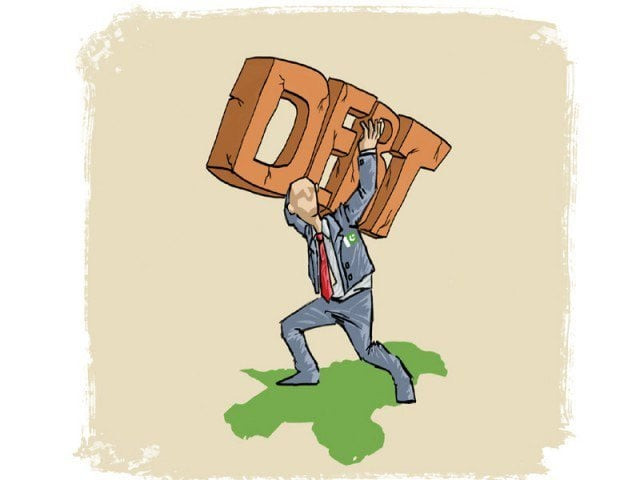Debt to remain major challenge
Finance ministry says debt accumulation slows down in second year of PTI govt

Mounting public debt would remain a major challenge but the pace of debt accumulation slowed down during the second year of Pakistan Tehreek-e-Insaf (PTI) government, the finance ministry said while briefing the federal cabinet.
In a presentation on the increase in public debt between June 2018 and June 2020, Adviser to Prime Minister on Finance Dr Abdul Hafeez Shaikh on Tuesday termed the last fiscal year (2019-20) a “good year” for debt.
In the previous fiscal year, which was the second year of PTI government, the pace of debt accumulation decreased by more than half when compared with the first year, the cabinet was informed.
The cabinet was apprised that the total public debt as of June 30, 2020 increased to Rs36.3 trillion or 87.2% of gross domestic product (GDP). There was an addition of Rs11.35 trillion or 45% to the total public debt in the past two years.
When the Pakistan Muslim League-Nawaz (PML-N) government left power, the total public debt stood at Rs24.95 trillion or 72.5% of GDP.
The federal cabinet was informed that Rs7.7 trillion was added to the total public debt in the first year of PTI government and debt accumulation in the second year was Rs3.7 trillion. As compared to the first year, the accumulation was lower by 52%.
The increase in primary deficit was also 50% less than the first year. Similarly, the exchange rate remained stable in the second year, which helped to contain the debt build-up.
However, officials stated that the finance adviser told the federal cabinet that public debt would remain a major challenge and it now required careful management.
The highest decision-making body of the country was told that there was a need to improve coordination between the government and lenders, and revenue had to be increased to control the public debt.
Moreover, Shaikh did not face tough questions in the meeting. Instead, Industries Minister Hammad Azhar, Education Minister Shafqat Mehmood and Economic Affairs Minister Khusro Bakhtyar praised the finance ministry.
The cabinet was told that debt management was also better in the second year of PTI government compared to the first year, due to contained primary deficit, exchange rate stability, improved quality of domestic debt portfolio and introduction of new debt instruments.
The cabinet was also told that the finance ministry issued more floating (variable) rate long-term bonds whose interest cost moved with the policy rate. In the last fiscal year, when the policy rate stood at 13.25%, the government borrowed slightly lower than the rate through floating instruments.
The quality of domestic debt also improved and the cost of borrowing was lowered.
As part of an understanding with the International Monetary Fund (IMF), the government would switch to long-term borrowing. It will reduce the stock of short-term debt being raised by auctioning treasury bills from Rs5.5 trillion as of June this year to Rs4.1 trillion by June next year, according to the finance ministry.
The stock of Pakistan Investment Bonds (PIBs) would jump from Rs12.4 trillion in June this year to Rs16.9 trillion within one year to replace short-term borrowing and meet financing needs of current fiscal year.
Although the finance ministry did not highlight the future debt path, it was unlikely that the government would be able to bring the debt level down due to poor revenue collection performance of the Federal Board of Revenue (FBR).
The FBR sustained a record Rs2.13 trillion shortfall in tax revenue in the first two years of PTI government but the prime minister did not hold anybody accountable.
The cabinet was informed that tax collection was growing at the rate of 17% until March 2020 but then it started going down due to Covid-19.
The cabinet was informed that external debt management also improved during the PTI’s second year. In the first year, lending by multilateral lenders almost dried up and their debt stock was reduced by a billion dollars to $34.2 billion.
After the start of the IMF programme, the lending by multilateral institutions increased by $5.2 billion to $39.4 billion.
Owing to PTI’s reliance on friendly countries, bilateral lending, which stood at $20.3 billion at the end of PML-N government, increased to $24 billion, which remained almost constant during the second year, according to the briefing.
Eurobond debt and foreign commercial loans decreased at the end of second year of PTI government.
Total external public debt, which was $70.2 billion at the end of PML-N government, increased to $78 billion by June 2020, the cabinet was informed.
The cabinet was told that about 42% of the additional public debt in the past two years was due to debt servicing expenses and another 31% because of currency devaluation.
In the past two years, Rs3.5 trillion was added to the public debt due to exchange rate depreciation, which was equal to 31% of the additional debt.
The cabinet was informed that during the first year of PTI government, the massive surge in public debt was because of correction of a “flawed exchange rate policy” of the PML-N government that added Rs3.1 trillion to the debt and Rs2.1 trillion in interest payments on past debt. Another over Rs1 trillion was added to generate cash buffers.
Published in The Express Tribune, September 30th, 2020.
Like Business on Facebook, follow @TribuneBiz on Twitter to stay informed and join in the conversation.



















COMMENTS
Comments are moderated and generally will be posted if they are on-topic and not abusive.
For more information, please see our Comments FAQ